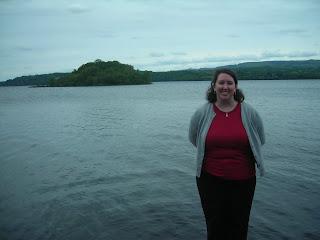
June 12th, a Sunday, was for the most part a Yeats day; however, our first stop had nothing to do with the poet! We began the day at Parke’s Castle, a 16th century castle built by one of Queen Elizabeth I’s soldiers, Captain Parke, on the site of an earlier Norman tower; the castle has displays of what life was like for the English Parke family, as well as the Irish peasants who lived in the surrounding village. My favorite moment, though, was when we were in one of the towers and our guide said that it was inhabited by migratory swallows. For the moment, we all suppressed the temptation to ask if they were African swallows and, if so, how a 5 ounce bird could carry a 1 pound coconut while migrating, but as soon as we were back in the bus, the Monty Python jokes just kept coming.

Our next stop was the Lake Isle of Innisfree, immortalized by Yeats in his poem of the same name. We didn’t go out to the island, but we did stand on the boat ramp looking at it while Juli read the poem. Since I’d done it everywhere else, I put my hand in the lake to feel the temperature—it was freezing! Innisfree is on a beautiful, peaceful lake, but we didn’t spend long there because as Juli finished reading, it started to rain, so we headed back to the bus.

On the way to Drumcliffe Church, Nigel took us on a slight detour; it was one of those unexpected side trips that so often end up being wonderful. We visited Tobernalt Holy Well, which is maintained by one of the nearby parishes. Tobernalt is one of many places in the western part of Ireland where, when Catholicism was illegal, priests would come to say Mass in secret. At the entrance to the Holy Well, there are signs calling for silence, then a plaque that begins “Walk softly, pilgrim, for this is holy ground.” It goes on to explain the history of the place and to remind the reader that the people who attended Mass there showed by their attendance their willingness to die for the Faith; it ends by asking if we too value our faith the same way. We spent a long time (I actually have no idea how much) just walking around the shrine, soaking it all in. I wandered around the perimeter, with its Stations of the Cross and Mysteries of the Rosary, then walked softly through the interior, stopping at the high altar and the smaller side shrines; at St. Anne, I lit a candle for Mom. The entire place was filled with holiness and Divine mystery; even after we’d left the site, the silence continued until we’d reached Drumcliffe Church.

Yeats’ grandfather was the rector at Drumcliffe, a pretty little church nestled underneath the mountain Ben Bulben, which is where Yeats decided he wanted to be buried; he is buried in the churchyard, though he wasn’t a huge fan of organized religion, preferring instead a rather New Age-y spiritualism that involved communing with spirits, etc. His grave, inscribed with an epitaph taken from his poem “Under Ben Bulben” (“Cast a cold Eye/On Life, on Death./Horseman, pass by!”), sits just to the left of the church; his wife Georgie is buried in the same place. Graveyards are some of my favorite places, especially in Ireland, where you have 20th century graves just a few yards from 10th century high crosses. The rain began to come down harder while we were there, so we returned to the bus for our picnic lunch.

We took a brief walk along the beach at Rosses’ Point because of the rain (did I mention that this was the day I accidentally left my poncho at the hotel? Because it was); we briefly lost Charlie and Drew and I took some fun pictures of Charles trying to be the statue of a woman waiting for her sailor; our group could make everything, even gross, rainy days, so much fun!

The final stop of the day was at Glencar Waterfall, the setting of one of my favorite Yeats poems, “The Stolen Child.” The climb to the waterfall was negligible because whoever maintains it has installed stairs and a handrail. Since it’s one of my favorites, Dr. Kelly let me read the poem out loud; all my years of vocal training came in handy as I tried to compete with the loud waterfall! Dr. Kelly shot a video, which I haven’t dared to watch yet, since I’m funny about hearing my own voice. Rebecca and I hosted dinner in our room (pizza graciously purchased by Dr. Kelly, beverages provided by students) and even Nigel joined us for a few slices and a drink. It was a good end to a cold and wet day.